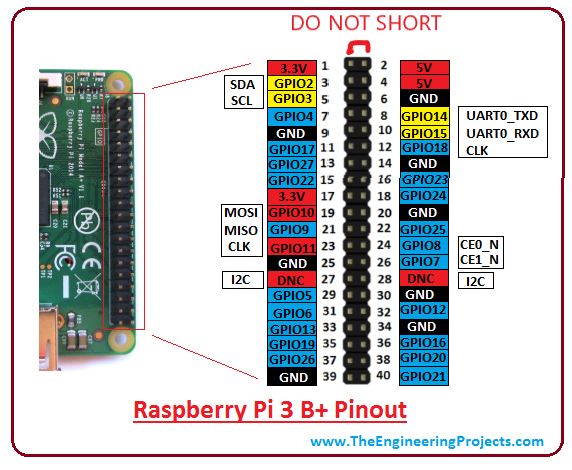LVR Monitor Hardware
LVR monitor general description
The Monitor as it presently exists consists of several pieces
- Raspberry pi model "3 B+" or newer with 5V adapter
- Interface (mouse/keyboard/monitor) for raspberry pi
- 4xABElectronics ADC Pi with 0.1"-pitch shrouded right angle headers
- One of:
- Custom built harness using 26-gauge stranded PTFE-insulated wire with CGRID-III crimp contacts housings
- LVR montior breakout PCB
- Software based on the libraries available from ABElectronics with modifications by PMH for faster sampling of all 28 channels
Raspberry pi pinout
Below is a pinout for the raspberry pi 3b+. 
Pins of interest for the LVR testing are: 1. the SDA and SCL i2c lines, which talk to the ADC Pi expansion boards. 2. The 5V and 3V (as well as GND) pins used to power and permenently pull up Zishuo's load board for the final QA 3. Pins 19, 21, 23 used by the SPI interface
To use the i2c and SPI interfaces with the raspbian OS they must be enabled via sudo raspi-config. For SPI it is recommended that the pin20 ground be connected to the LVR as well if possible, though it is not strictly necessary if the LVR is not powering anything and the various system grounds are well-behaved.
ADC Pi notes
Mostly of note here is the fact that the inputs are run through a 10k/6.8k voltage divider. This means that any resistance in series with the input changes the voltage divider, which must be corrected in software. For example, if you measure a voltage on the LVR that has a 1k resistor before the pin, your measurement will be too low by a factor of 16,800/17,800 and you need to scale what the software gives you up to compensate.
The ADC boards each has one of several recommended i2c addresses, shown below. The physical order for the intial QA Rpi is Configuration 1 at the bottom closest to the Raspberry pi and then 2, 3, 4 moving up the stack, the final QA has the order reversed because oops.
In the LVR monitor python script, the following assignments are assumed:
| Configuration Number | Inputs |
|---|---|
| 1 | Housekeeping (3v3,1v5,V_OP,temp) |
| 2 | V_OUT |
| 3 | V_SENSE |
| 4 | i_MON outputs |
LVR - pi interface
The interface between the Raspberry Pi + ADCs and the LVR is through the TCM connector on the LVR. The general diagram of the desired connections is shown below and is also available in PDF form here.
This harness is implemented either in the wire harness (should be back at the desk by the shelves, and should be usable as backup) or as a breakout board plus IDC connectors. The breakout board was produced by PCB express and, unfortunately, contains some errors which have been corrected within software or by reworking. I've tried to document them below as best I can. In the latter case, the reworks include the addition of R3 as shown above, and a correction to how R1 and R2 are connected.